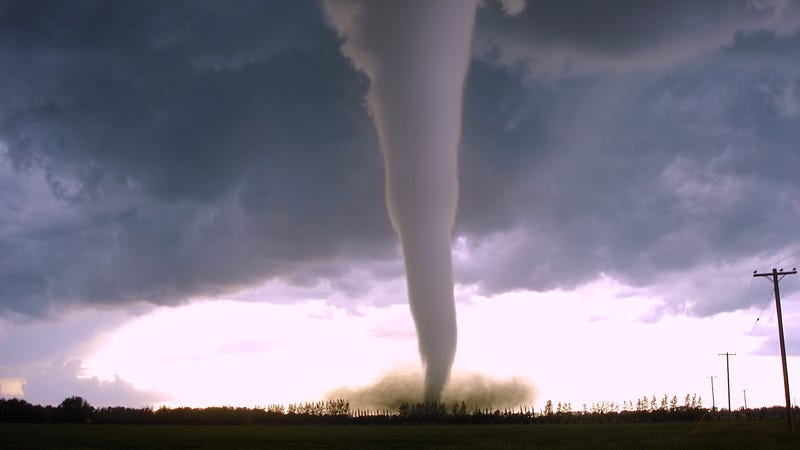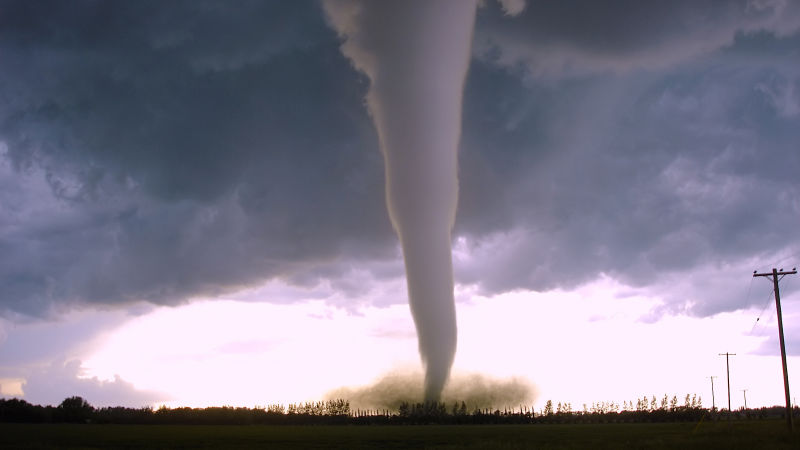
Every year, around 1,200 tornadoes hit the United States, destroying everything in their path. They can form almost anywhere, in any season, and bring with them 300 mph winds and funnels that can be more than a mile wide. This is what you need to know to survive one of Mother Nature’s most brutal offspring.
Where and When They Occur
Most tornadoes in the U.S. occur east of the Rocky Mountains. They are especially concentrated in the central and southern plains (what’s commonly known as “Tornado Alley”), as well as the Gulf Coast and parts of Florida. That said, tornadoes can occur just about anywhere, so it’s good to be prepared for them wherever you live. Once they form, tornadoes tend to move southwest to northeast, but they have been known to change direction.
While tornadoes can occur any time during the year, they’re most likely to strike in the spring and summer months. More often than not, they happen in the late afternoon and early evening when the pressure is rapidly changing, usually between 3 and 9 p.m.
Advertisement
Know the Warning Signs
Tornadoes can strike quickly and seemingly out of nowhere, but there are usually warning signs of some kind. Make sure you know what different weather warnings mean:
- Severe thunderstorm watch: Weather conditions suggest severe thunderstorms may develop in your area. Severe thunderstorms are an early warning sign of a potential tornado.
- Severe thunderstorm warning: A severe thunderstorm has been observed by spotters or indicated on radar, and is occuring in your area. These storms can produce rain, lightning, hail, and wind of at least 58 mph. These warnings last for around an hour, or until the storm passes or upgrades to something more severe.
- Tornado watch: Weather conditions suggest severe thunderstorms are likely and may develop into tornadoes in your area. If you see this warning, review your emergency plans and start preparing for the worst.
- Tornado warning: It’s happening right now! A tornado has been spotted or indicated on radar in your area, so engage in your emergency plan or take cover immediately.
Advertisement
If you’re not near your phone, or in an area with poor coverage, there are other tornado signs. Look and listen for:
- Dark, greenish thunderstorm clouds
- Dark, low-lying clouds (especially if rotating)
- Large hail or heavy rain
- Whirling dust or debris on the ground (tornadoes don’t always have a funnel)
- Loud, continuous roar that sounds like thunder or a freight train (but never fades away)
Advertisement
Knowing these warning signs can save you a ton of time, and time is of the essence in emergency situations.
When the Tornado Strikes
Advertisement
Once a warning has been issued, or you can see the storm approaching yourself, it’s time to seek shelter immediately. Do not hesitate! Keep in mind, wherever you end up, be sure to protect your head. Most tornado injuries involve flying debris. And never leave a building in an attempt to escape a tornado. You can’t outrun it.
If you’re at home
Go inside and move to a small interior, windowless room. The lower the room, the better. If you have a basement or cellar, go there. Stay away from corners, windows, doors, and outside walls. The idea is to put as many walls between you and the outside as possible. Once you’re in a safe room, get under a sturdy table or desk, cover your head and neck with your arms, a heavy coat, a thick blanket, or pillows to protect from debris. If you live in a manufactured or mobile home, leave immediately and head to the closest sturdy building. Mobile homes offer very little protection. Keep pets on a leash or in a crate or carrier.
Advertisement
If you’re at work or school
Head to a pre-designated safe area, like a safe room, storm cellar, or a windowless interior room. If you are in a high-rise building, head to a small interior room on the lowest floor possible. If possible, avoid any buildings with long-spanning roof areas, like gymnasiums, arenas, or shopping malls. These buildings have a high chance of collapsing from pressure during tornadoes. Follow the instructions of your office safety officer or teacher.
Advertisement
If you’re in a hotel or airport
Hotels may have a basement or other designated safe area. Follow the instructions of hotel staff. Otherwise, seek shelter in interior bathrooms or closets near the center of the building. Protect yourself with pillows, blankets, and mattresses. Be sure to inform management of any injuries or damaged property when it’s all over.
If you’re in a concourse or terminal of an airport during a tornado warning, airport staff should guide you to a safe area (often designated tornado shelters). You may be advised to leave your luggage behind, so do as instructed.
Advertisement
If you’re in your car or truck
Do not try to outrun a tornado—it’s faster than you and doesn’t have to stick to roads. Instead, safely drive to the nearest sturdy-looking building. Once there, park your car outside of any traffic lanes and get inside. If you’re caught inside your vehicle: park, make sure your seat belt is on, put your head down below the windows, and cover your head and neck with a coat, blanket, seat cushion, or your hands. The vehicle’s airbags and frame will offer some protection. Never seek shelter under a bridge or overpass. You’re safer in a low, flat, open location.
If you’re outside
If reaching shelter in time is not possible, you have a couple of options. If you can get next to a building, do so and crouch next to a strong wall. If you’re totally out in the open, get away from trees, cars, and other potentially deadly debris, then lie face down, flat in a ditch or other low-lying area. Cover your head and neck with whatever you have.
Advertisement
After the Tornado
If you’re trapped by debris, FEMA recommends you don’t try to move, kick up dust, or push your way out. You may be injured and could make things worse for yourself. Instead, tap on a pipe, wall, or other material that makes a sound. Whistle or yell if you can so rescuers can locate you.
Advertisement
When the storm has passed, check in with your family and friends to make sure nobody is hurt. Keep them together during the aftermath. Switch on your radio and listen for instructions from local officials and emergency personnel. Use extreme caution as you begin to clean up. Stay away from debris, damaged buildings, and downed power lines, and watch for broken glass and other sharp objects on the ground. Be sure to wear protective clothing while you handle debris, and don’t try to lift heavy debris by yourself. If your power is out, use flashlights and lamps—not matches, lighters, or candles. You don’t want to have to add a fire onto your insurance claim.













